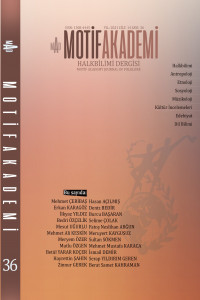OSMANLI İMPARATORLUĞU’NDA BİR ARADA YAŞAMA KÜLTÜRÜNE BAĞLI OLARAK GELİŞEN MÜSLÜMAN VE GAYRİMÜSLİM KIYAFETLERİ
MUSLIM AND NON-MUSLIM CLOTHING THAT WAS DEVELOPED DEPENDING ON THE CULTURE OF LIVING TOGETHER IN THE OTTOMAN EMPIRE
Author(s): Burcu BaşaranSubject(s): Modern Age, Islam studies, Cultural Anthropology / Ethnology, The Ottoman Empire, Sociology of Religion
Published by: Motif Halk Oyunları Eğitim ve Öğretim Vakfı
Keywords: Ottoman clothing; Muslim clothing; non-muslim clothing; dhimmi clothing, giyar (the symbol; sign separating the non-muslims from the Muslims);
Summary/Abstract: The Ottoman ruling which expanded for centuries through including different religious and ethnic communities has organized political, economic and cultural life in an inclusive way that is embracing and at the same time benefiting from differences, without assimilation of differences. When we consider the Ottoman Empire, which has different cultures one more special than the other on three continents, it is impossible not to recognize and admire the dress aesthetics and diversity created by other nations through distilling from their own cultures and fine pleasures. While the clothes, jewelry and accessories worn by Muslims and nonmuslims reveal their belonging to a certain community; it also places ethnographic fashion, which presents an aesthetic appearance, into art history. In this research, which is based on literature review, it has been tried to determine applied regulations by the Ottoman Empire for Muslims and non-muslims through clothing of Muslim women, men and non-muslim women, men in the Ottoman period. The rich clothing styles of the Muslim and non-muslim nations, which were under the rule of the empire, developed in the cultural and belief planes, and the social, religious and economic regulations and restrictions that the Ottoman Empire brought to the dress styles in order to distinguish Muslims and non-muslims from each other, are the subject of this study in general terms. As a result of the obtained data, it has been determined that Muslim and non-muslim clothes and accessories are used with symbols that provide difference and distinctiveness from each other.
Journal: Motif Akademi Halkbilimi Dergisi
- Issue Year: 14/2021
- Issue No: 36
- Page Range: 1367-1383
- Page Count: 17
- Language: Turkish

